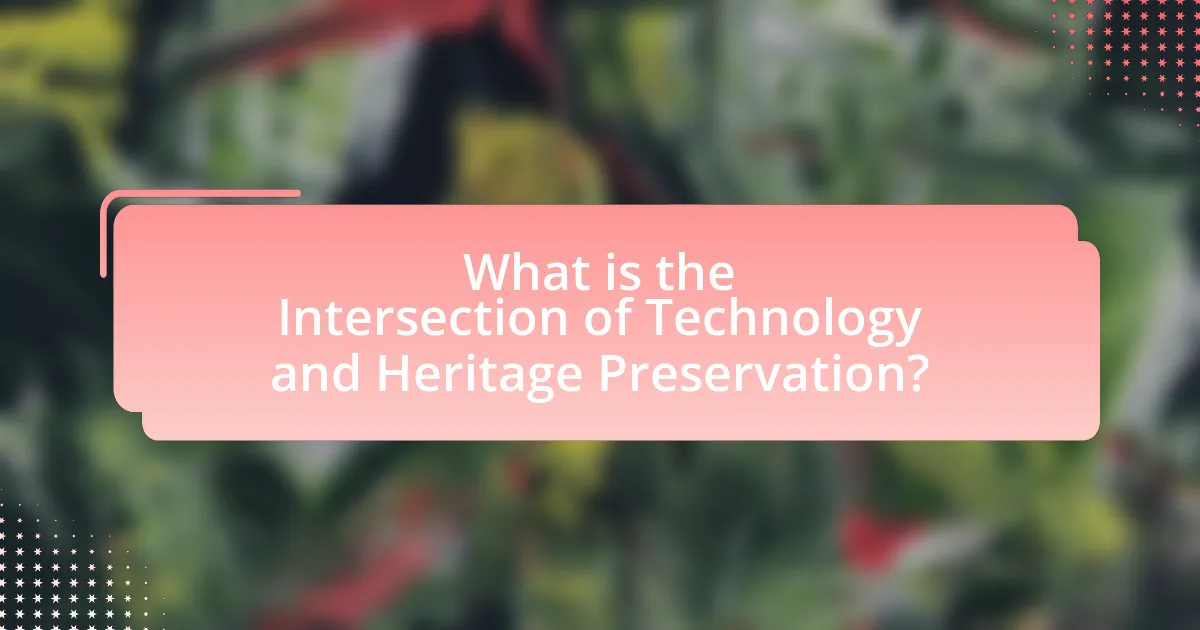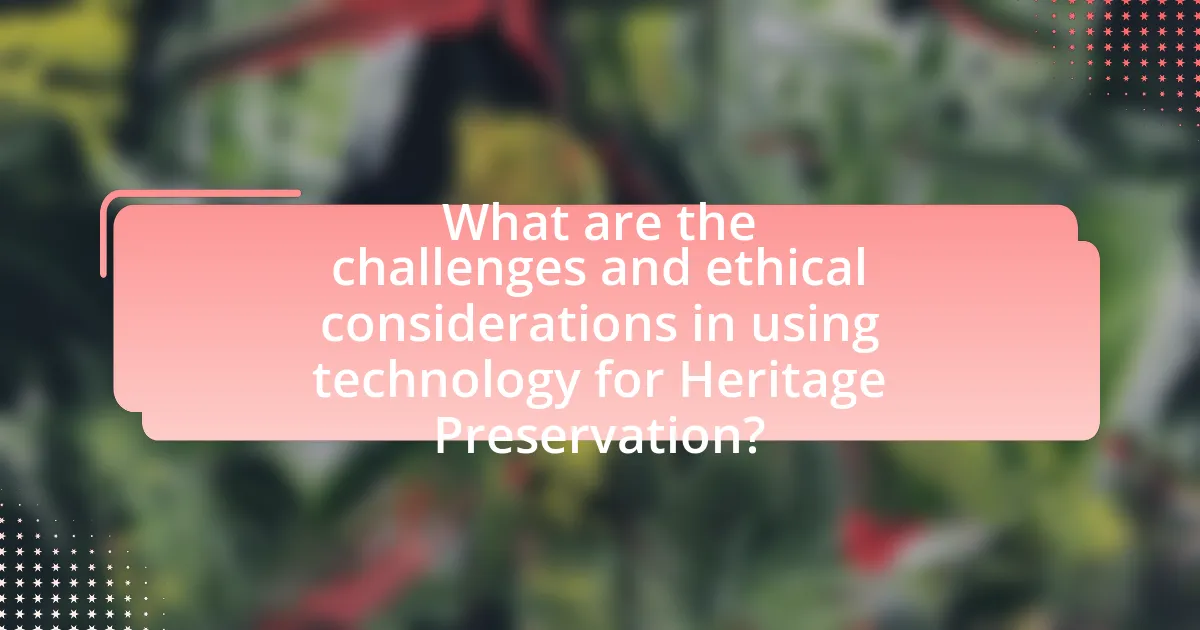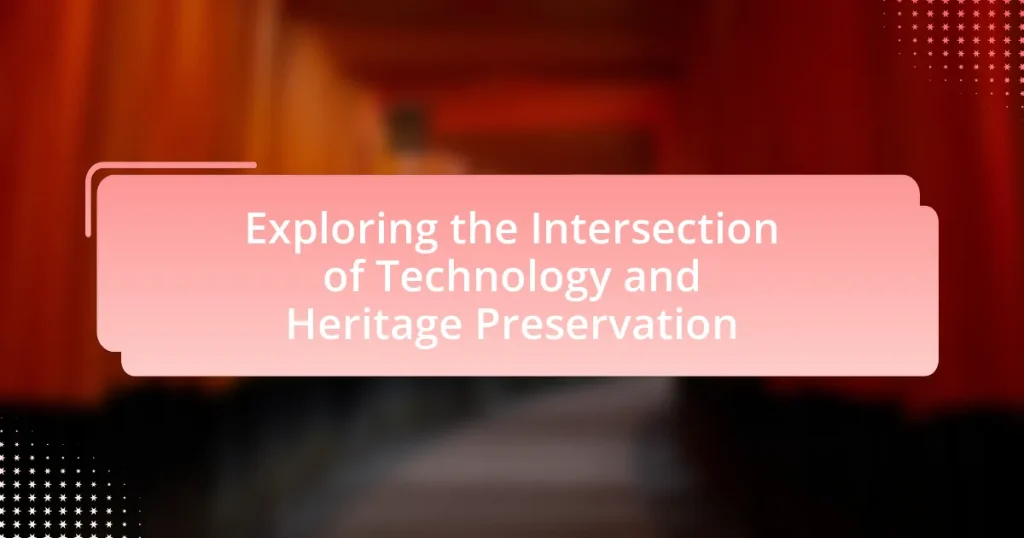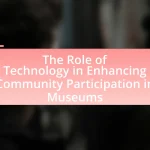The article explores the intersection of technology and heritage preservation, highlighting how digital tools and methodologies enhance the protection, documentation, and restoration of cultural heritage. Key advancements such as 3D scanning, virtual reality, and Geographic Information Systems (GIS) are discussed, illustrating their roles in accurately recording historical sites and artifacts. The article also addresses the evolution of technology in preservation, its impact on traditional methods, and the importance of ethical considerations in using technology for heritage conservation. Additionally, it examines the benefits of public engagement through digital platforms and the challenges posed by reliance on technology in preserving cultural integrity.

What is the Intersection of Technology and Heritage Preservation?
The intersection of technology and heritage preservation involves the application of digital tools and methodologies to protect, document, and enhance cultural heritage. Technologies such as 3D scanning, virtual reality, and digital archiving enable the accurate recording of historical sites and artifacts, facilitating their preservation for future generations. For instance, the use of 3D modeling allows for the reconstruction of damaged structures, as seen in the restoration of the Notre-Dame Cathedral after the 2019 fire, where digital technologies played a crucial role in planning the restoration efforts. Additionally, initiatives like the UNESCO World Heritage Centre’s use of Geographic Information Systems (GIS) help monitor and manage heritage sites, ensuring their conservation amidst environmental threats.
How has technology evolved in the context of heritage preservation?
Technology has evolved significantly in the context of heritage preservation through advancements in digital documentation, conservation techniques, and public engagement. Digital tools such as 3D scanning and photogrammetry allow for precise documentation of heritage sites, enabling detailed virtual reconstructions and analyses. For instance, the use of laser scanning has been instrumental in creating accurate digital models of historical structures, which can be used for restoration and educational purposes. Additionally, technologies like augmented reality (AR) and virtual reality (VR) enhance visitor experiences by providing immersive interpretations of heritage sites, making history more accessible. The integration of Geographic Information Systems (GIS) has also improved the management and monitoring of heritage sites, allowing for better planning and resource allocation. These technological advancements not only aid in the preservation of cultural heritage but also foster greater public awareness and appreciation of historical significance.
What are the key technological advancements impacting heritage preservation?
Key technological advancements impacting heritage preservation include 3D scanning, digital documentation, and conservation robotics. 3D scanning allows for precise digital replicas of artifacts and sites, facilitating analysis and restoration efforts without physical interference. Digital documentation, through techniques like photogrammetry and GIS mapping, enables comprehensive records of heritage sites, aiding in monitoring and management. Conservation robotics, such as drones and automated cleaning systems, enhance accessibility and preservation efforts in hard-to-reach areas, ensuring that delicate structures are maintained without human risk. These technologies collectively improve the efficiency and effectiveness of heritage preservation initiatives.
How do these advancements change traditional preservation methods?
Advancements in technology significantly enhance traditional preservation methods by introducing more efficient and precise techniques for documentation, analysis, and restoration. For instance, 3D scanning and digital modeling allow for accurate representations of artifacts and sites, enabling better planning for conservation efforts. Additionally, the use of non-invasive imaging technologies, such as infrared and ultraviolet photography, provides insights into the condition of materials without causing damage. These innovations lead to improved decision-making in preservation strategies, as evidenced by the successful application of these methods in projects like the restoration of the Sistine Chapel, where digital tools facilitated a meticulous approach to conservation.
Why is the intersection of technology and heritage preservation important?
The intersection of technology and heritage preservation is important because it enhances the methods and effectiveness of conserving cultural heritage. Technology, such as 3D scanning and digital archiving, allows for precise documentation and restoration of historical sites and artifacts, ensuring their longevity. For instance, the use of laser scanning has been instrumental in capturing detailed measurements of structures like the Notre-Dame Cathedral, which aids in restoration efforts after damage. Furthermore, digital platforms facilitate broader access to heritage resources, enabling global audiences to engage with and learn from cultural history, thereby fostering appreciation and awareness.
What role does technology play in enhancing public engagement with heritage sites?
Technology significantly enhances public engagement with heritage sites by providing interactive and immersive experiences. For instance, augmented reality applications allow visitors to visualize historical events and reconstructions in real-time, making the learning process more engaging. According to a study published in the Journal of Cultural Heritage Management and Sustainable Development, 70% of visitors reported increased interest in heritage sites after using digital tools like mobile apps and virtual tours. These technologies not only attract a broader audience but also facilitate educational opportunities, allowing users to access detailed information and narratives about the site’s history and significance.
How does technology contribute to the sustainability of heritage preservation efforts?
Technology enhances the sustainability of heritage preservation efforts by enabling efficient documentation, monitoring, and restoration processes. For instance, 3D scanning and modeling allow for precise digital records of heritage sites, which can be used for virtual tours and educational purposes, reducing physical wear on the sites themselves. Additionally, remote sensing technologies, such as drones and satellite imagery, facilitate ongoing monitoring of environmental conditions affecting heritage sites, allowing for timely interventions. A study by the Getty Conservation Institute highlights that integrating digital tools in conservation practices not only preserves the physical integrity of heritage sites but also promotes public engagement and awareness, ensuring long-term support for preservation initiatives.

What are the main technologies used in Heritage Preservation?
The main technologies used in heritage preservation include 3D scanning, Geographic Information Systems (GIS), and digital archiving. 3D scanning allows for precise documentation of artifacts and structures, enabling detailed analysis and restoration efforts. GIS technology aids in mapping and managing heritage sites, facilitating better planning and conservation strategies. Digital archiving preserves historical documents and images, ensuring accessibility and protection against deterioration. These technologies collectively enhance the preservation process by providing accurate data and innovative solutions for maintaining cultural heritage.
How do digital tools aid in the documentation of heritage sites?
Digital tools significantly enhance the documentation of heritage sites by enabling precise data collection, visualization, and analysis. Technologies such as 3D scanning and photogrammetry allow for the creation of detailed digital models, capturing intricate architectural features and spatial relationships. For instance, a study by the University of Southern California demonstrated that 3D laser scanning can achieve millimeter-level accuracy in documenting historical structures, facilitating better preservation efforts. Additionally, Geographic Information Systems (GIS) provide a platform for integrating various data types, such as historical records and environmental factors, which aids in comprehensive site management and planning. These digital methodologies not only improve the accuracy of documentation but also promote accessibility and engagement with heritage sites through virtual tours and interactive platforms.
What are the benefits of using 3D scanning and modeling in preservation?
The benefits of using 3D scanning and modeling in preservation include enhanced accuracy in documentation, improved accessibility for research and education, and the ability to create detailed digital archives. Enhanced accuracy is achieved through high-resolution data capture, which allows for precise measurements and representations of artifacts and structures, minimizing the risk of loss during physical handling. Improved accessibility is facilitated by the ability to share digital models globally, enabling wider public engagement and scholarly research without the need for physical presence. Additionally, creating detailed digital archives ensures that even if physical items deteriorate or are damaged, their digital counterparts remain intact for future study and reference.
How does Geographic Information Systems (GIS) technology support heritage management?
Geographic Information Systems (GIS) technology supports heritage management by enabling the mapping, analysis, and visualization of cultural and historical sites. GIS allows heritage managers to create detailed spatial databases that include information on site locations, conditions, and historical significance. For instance, GIS can be used to assess the impact of urban development on archaeological sites, helping to inform preservation strategies. Studies have shown that GIS applications in heritage management enhance decision-making processes by providing data-driven insights, which can lead to more effective conservation efforts and resource allocation.
What role does social media play in heritage preservation?
Social media plays a crucial role in heritage preservation by facilitating awareness, engagement, and community involvement. It allows organizations and individuals to share information about cultural heritage sites, promote preservation efforts, and mobilize support for initiatives. For instance, platforms like Facebook and Instagram enable users to document and showcase heritage sites, increasing visibility and appreciation. According to a study published in the Journal of Cultural Heritage Management and Sustainable Development, social media campaigns have successfully raised funds and awareness for various heritage projects, demonstrating its effectiveness in mobilizing community action and resources.
How can social media campaigns raise awareness about heritage sites?
Social media campaigns can raise awareness about heritage sites by leveraging visual storytelling and community engagement to reach a broader audience. These campaigns utilize platforms like Instagram, Facebook, and Twitter to share captivating images, videos, and narratives that highlight the cultural significance and historical context of these sites. For instance, UNESCO has effectively used social media to promote World Heritage Sites, resulting in increased public interest and visitation. According to a study published in the Journal of Cultural Heritage Management and Sustainable Development, social media engagement can enhance public knowledge and appreciation of heritage, leading to greater advocacy for preservation efforts.
What are the challenges of using social media for heritage preservation?
The challenges of using social media for heritage preservation include issues of authenticity, misinformation, and the digital divide. Authenticity is compromised when users share altered or misleading representations of heritage sites, which can distort public perception and appreciation. Misinformation can spread rapidly on social media platforms, leading to confusion about the significance and history of cultural heritage. Additionally, the digital divide means that not all communities have equal access to social media, potentially excluding marginalized groups from participating in heritage discussions and preservation efforts. These challenges highlight the need for careful management and critical engagement with social media in the context of heritage preservation.

What are the challenges and ethical considerations in using technology for Heritage Preservation?
The challenges and ethical considerations in using technology for heritage preservation include issues of authenticity, accessibility, and the potential for cultural appropriation. Authenticity is compromised when digital reconstructions or alterations do not accurately represent the original heritage, leading to misinterpretations. Accessibility can be problematic as technology may favor certain demographics, excluding marginalized communities from participating in preservation efforts. Cultural appropriation arises when technologies are used to replicate or commercialize heritage without proper consent or respect for the originating culture. These challenges highlight the need for ethical frameworks that prioritize community involvement and respect for cultural significance in heritage preservation initiatives.
What are the potential risks of relying on technology in preservation efforts?
Relying on technology in preservation efforts poses several potential risks, including data loss, obsolescence, and over-dependence on digital formats. Data loss can occur due to hardware failures or cyber-attacks, which can compromise the integrity of preserved materials. For instance, a 2019 study by the Digital Preservation Coalition highlighted that 30% of organizations reported losing access to digital assets due to technological failures. Obsolescence is another significant risk, as software and hardware can become outdated, rendering preserved data inaccessible; the rapid pace of technological advancement means that formats may no longer be supported within a few years. Additionally, over-dependence on technology can lead to neglect of traditional preservation methods, which are often more reliable and sustainable. These risks underscore the need for a balanced approach that integrates both technology and traditional practices in heritage preservation.
How can technology lead to the commodification of heritage?
Technology can lead to the commodification of heritage by enabling the digitization and commercialization of cultural artifacts and experiences. This process allows heritage sites and objects to be transformed into marketable products, such as virtual reality experiences, digital replicas, and online tours, which can be sold to consumers. For instance, the use of 3D scanning technology has made it possible to create accurate digital models of historical sites, which can then be monetized through virtual tourism platforms. Additionally, social media and e-commerce platforms facilitate the promotion and sale of heritage-related merchandise, further blurring the lines between cultural preservation and commercial exploitation. This trend raises concerns about the authenticity and integrity of heritage, as the focus shifts from preservation to profit generation.
What ethical dilemmas arise from digital reproductions of heritage sites?
Digital reproductions of heritage sites raise ethical dilemmas related to authenticity, ownership, and accessibility. The authenticity dilemma arises when digital replicas may misrepresent the original site’s cultural significance, leading to a diluted understanding of heritage. Ownership issues emerge as stakeholders, including local communities and governments, may contest rights over digital representations, complicating the preservation narrative. Accessibility concerns highlight the risk of digital reproductions being prioritized over physical preservation, potentially diverting resources from maintaining the actual sites. These dilemmas underscore the need for careful consideration in the use of technology for heritage preservation.
How can stakeholders balance technology and traditional preservation methods?
Stakeholders can balance technology and traditional preservation methods by integrating digital tools with established practices to enhance conservation efforts. For instance, using 3D scanning technology allows for precise documentation of heritage sites while traditional methods ensure the physical integrity of materials is maintained. Research indicates that combining these approaches can lead to more effective preservation outcomes, as seen in projects like the restoration of Notre-Dame Cathedral, where digital modeling aided in planning while traditional craftsmanship was employed for repairs. This synergy not only preserves cultural heritage but also makes it more accessible for future generations.
What strategies can be employed to integrate technology without compromising authenticity?
To integrate technology without compromising authenticity, employing strategies such as participatory design, context-sensitive applications, and the use of augmented reality can be effective. Participatory design involves engaging stakeholders, including local communities and heritage experts, in the technology development process to ensure that the technology reflects their values and narratives. Context-sensitive applications adapt technology to the specific cultural and historical context of the heritage site, ensuring that it enhances rather than detracts from the authentic experience. Augmented reality can provide immersive experiences that overlay digital information onto physical sites, allowing visitors to engage with the heritage in a meaningful way while preserving the site’s integrity. These strategies have been supported by case studies, such as the use of augmented reality in the preservation of ancient ruins, which demonstrated that technology can enhance visitor engagement without altering the site’s authenticity.
How can collaboration between technologists and preservationists enhance outcomes?
Collaboration between technologists and preservationists enhances outcomes by integrating advanced technologies with traditional preservation methods, leading to more effective conservation strategies. For instance, the use of 3D scanning and modeling allows preservationists to create accurate digital replicas of artifacts, which can be used for analysis and education without risking damage to the originals. A study by the Getty Conservation Institute highlights that such technological integration not only improves documentation but also facilitates better decision-making in preservation practices. This synergy ultimately results in more sustainable and informed approaches to heritage conservation.
What best practices should be followed when implementing technology in heritage preservation?
Best practices for implementing technology in heritage preservation include conducting thorough assessments of the site’s historical significance, ensuring community engagement, and prioritizing sustainable methods. Assessments help identify the unique attributes of heritage sites, guiding appropriate technological applications. Community engagement fosters local support and ensures that technology aligns with cultural values. Sustainable methods, such as using environmentally friendly materials and energy-efficient systems, preserve the integrity of heritage sites while minimizing ecological impact. These practices are supported by case studies, such as the use of 3D scanning in the preservation of ancient structures, which demonstrates how technology can enhance conservation efforts without compromising historical authenticity.
How can organizations ensure the longevity of digital records of heritage sites?
Organizations can ensure the longevity of digital records of heritage sites by implementing robust digital preservation strategies. These strategies include regular data backups, utilizing multiple storage formats, and employing metadata standards to maintain accessibility and usability over time. For instance, the Library of Congress emphasizes the importance of format migration and regular audits to prevent data loss, highlighting that digital records can become obsolete if not actively managed. Additionally, organizations should adopt cloud storage solutions that offer redundancy and disaster recovery options, as demonstrated by the National Archives, which utilizes cloud technology to safeguard its digital collections. By integrating these practices, organizations can effectively protect and sustain the integrity of digital heritage records for future generations.
What guidelines should be established for ethical technology use in preservation?
Ethical technology use in preservation should prioritize transparency, consent, and cultural sensitivity. Transparency involves clearly communicating the purpose and methods of technology used in preservation efforts, ensuring stakeholders understand how their heritage is being represented and maintained. Consent requires obtaining permission from communities and individuals whose heritage is being preserved, respecting their rights and perspectives. Cultural sensitivity emphasizes the importance of understanding and honoring the cultural significance of artifacts and practices, avoiding appropriation or misrepresentation. These guidelines are essential to foster trust and collaboration between technology developers, preservationists, and the communities involved, ultimately leading to more respectful and effective preservation practices.


